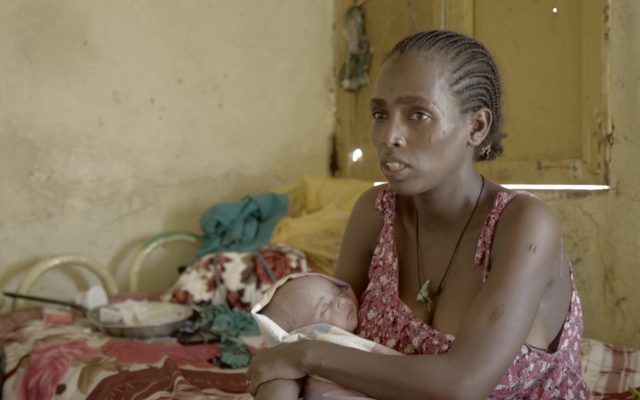Thanks for cooking with us! Get ready for some more Middle Eastern recipes
We were joined by cooking enthusiasts who wanted to learn the very best in Middle Eastern recipes – people dialled in from all corners of the UK, and around the world including Canada, Malaysia, Tanzania, Nicaragua, and more.
© UK for UNHCR
Thank you for joining our first ever virtual cookalong.
For those who couldn’t make it, and for those who did, it’s not too late to try making Majeda’s delicious Harrak Isbaao at home yourselves.
And for anyone looking to impress their loved ones this summer, we also have two new Middle Eastern recipes to try your hand at below.
Chef and co-author of Palestinian cookbook, Falastin, Tara Wigley has shared her beloved Shatta recipe, a fiery relish found on every Palestinian table.
And award winning baker and author of The Bread Book, Linda Collister has shared her favourite Lavash recipe – a traditional Middle Eastern flatbread to liven up your summer dinner parties.
So grab your apron and get cooking some delicious Middle Eastern food!
Majeda’s Harrak Isbaao
View this post on Instagram
A comforting Syrian dish of lentils and pasta, perfect for a night in with friends.
Serving: 2 people
Ingredients:
- 150g block of tamarind (or 3 tablespoon of tamarind paste/2 tablespoons of tamarind powder, mixed with 2 cups of hot water and put to one side
- 150g green or brown lentils, washed
- 100ml pomegranate molasses
- 75g macaroni (or penne)
- 100ml olive oil
- 250g fresh coriander, stems removed and chopped (keep half aside for the garnish)
- Salt and pepper to taste
For the Garnish:
- 2 tablespoons of flour or (breadcrumbs)
- 1 medium white onion, finely sliced
- 1 flat bread, cut into 1cm squares (tortilla, flat bread, pitta bread
- 300ml vegetable oil for deep frying
- 1/2 pomegranate, seeds removed
Instructions
- Heat 2 cups of water until hot, but not boiling, and pour it into a bowl. Break the tamarind (if using a block) into the bowl and soak it for 20 minutes. The water should turn deep brown and the tamarind should turn to a soft pulp.
- Place the lentils in a medium pot with 2 ½ cups of water. Bring to a boil, then reduce the heat and simmer for 15 minutes. Once the lentils are soft, add the tamarind liquid and the pomegranate molasses (don’t worry if you still have a little water left in the pot from cooking the lentils).
- Add the macaroni to the pot with the lentils, mix with salt and pepper to taste, and stir frequently for 10 minutes until the macaroni is cooked. Remove from the heat and set aside.
- Warm the olive oil in a frying pan on low-medium heat. Add the garlic with half of the coriander and stir for 2-3 minutes before adding it to the lentils.
For the Garnish:
- Combine the sliced white onion with the flour and shake to coat evenly. Place the floured onions in a sieve and gently shake to remove any excess flour.
- Heat the vegetable oil in a frying pan. Deep fry the bread pieces, followed by the onions in batches, until brown and crispy (you can shallow fry if you prefer). Drain on kitchen paper and set aside
- Take a large shallow bowl or serving dish. Start with the lentils/macaroni. Top with a decorative pattern of the fried bread, fried onions, the remaining half of the chopped coriander and pomegranate seeds.
Shatta (red or green)
This fiery condiment is as easy to make as it is to get addicted too.
Serving: Makes 1 medium jar
Ingredients:
- 250g red or green chillies, stems trimmed and then very thinly sliced (with seeds)
- 1 tablespoon salt
- 3 tablespoons cider vinegar
- 1 tablespoon lemon juice
- Olive oil, to cover and seal
Directions
- Place the chillies and salt in a medium sterilised jar and mix well. Seal the jar and store in the fridge for three days.
- On the third day, drain the chillies, transfer them to a food processor and blitz: you can either blitz well to form a fine paste or roughly blitz so that some texture remains.
- Add the vinegar and lemon juice, mix to combine, then return the mixture to the same jar.
- Pour enough olive oil on top to seal, and keep in the fridge.
Tips: As always with anything being left to ferment, the jar you put your chillies into needs to be properly sterilised. Once made, Shatta will keep in the fridge for up to six months. The oil will firm up and separate from the chillies once it’s in the fridge, so give it a good stir, for everything to combine, before using.
Recipe taken from Falastin: A Cookbook by Sami Tamimi and Tara Wigley (Ebury Press)
Lavash
Serving: Makes about 15.
Ingredients:
- 110g stoneground fine wholemeal flour (the kind used for pastry making)
- 340g strong white bread flour
- 5g salt
- 7g sachet easy-blend dried yeast
- 280g lukewarm water
- Extra flour for dusting
Will need a griddle or cast iron frying pan for cooking.
Directions
- Mix the flours, salt and yeast in a large mixing bowl. When thoroughly combined, using your hand, mix in enough lukewarm water to make a soft but not sticky dough.
- Tip the dough out of the bowl on to a work top lightly dusted with flour and knead for 5 minutes or until the dough feels very smooth.
- Put the dough back into the bowl and cover with a damp tea towel, or use a bowl with a snap on lid. Leave at room temperature until the dough has doubled in size, about 1 hour.
- Tip the dough out onto the work top again lightly dusted with flour and punch it down to deflate it. Divide into 15 egg-sized pieces, and shape each into a smooth neat ball. Cover with a dry tea towel and leave to rest for 30 minutes.
- Working with one ball of dough at a time, roll it out as thinly as possible to make an almost translucent disc about 12.5 cm across. Dust off any excess flour as this will scorch in the pan marring the flavour and appearance of the final lavash.
- Heat the griddle or pan until very hot, add one round and cook for about 1 minute until the underside is lightly browned on top of the bubbles. Flip it over and briefly cook the second side for (at most) 30 seconds.
- Remove with a palette knife and briefly cool on a wire rack, or on a rack covered with a dry tea towel for a softer more flexible bread.
- Keep cooking the dough in the same way, and eat ASAP.
Recipe taken from The Bread Book, by Linda Collister and Anthony Blake (Conran Octopus).
For more information on Middle Eastern recipes (and food from elsewhere in the world) and so much more, visit our friends at Migrateful.




